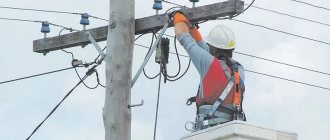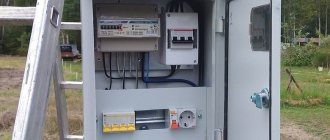What you need to pay attention to first
Twenty-five years ago and earlier, houses were designed taking into account the supply of only 3 kW. In such a house, the old wiring is not suitable for connecting 15 kW. The wires in the walls need to be changed or supplemented with new ones.
Later, at the beginning of our century, the cross-section of wires in houses provided a connection of 5 kW, 220 V. Make a three-phase connection to such a house, with a total power of 15 kW. In this case, you need to supplement the wiring of two more phases. It's easier than rewiring the entire house.
Single-phase or three-phase voltage with a power of up to 15 kW can be supplied to the new area. If the power line is within 25 m, connection is possible within two warm months or less. Otherwise, the work period may be more than 6 months. Choose a site taking into account the location of power lines.
Let's say you need more than 15 kW to power all the loads in the house. Find out in advance the possibility of supplying additional power from the organization servicing the power lines.
The address of the organization servicing the nearest power lines can be found out from neighbors or the local administration. Officials must respond to a written request within 15 days.
Where to start
So, you have decided on a plot and a house. You have insufficient power or a project for a new building. Before starting further actions, you need to make a justification for connecting 15 kW. That is, list the appliances and devices that you plan to use in the house and on the site.
Making a list is easy. For example:
- Washing machine - 1.5 kW.
- Refrigerator - 0.8 kW.
- Boiler - 2.5 kW.
- Iron - 1.2 kW.
- Electric kettle - 2 kW.
- Well pump - 1.5 kW.
- Pumping station to ensure water supply - 0.8 kW.
- Music video center - 1.2 kW.
- 3 computers, total power - 1.5 kW.
Total: 13 kW.
Another 2 kW is missing. Add 2kW electric underfloor heating in the bathroom. Or another load that must work together with the listed devices simultaneously. Even if you don’t plan to install heated floors, no one knows this except you. By defining a list of devices operating simultaneously, you will justify supplying 15 kW to the house, and not less power.
If your home already has electricity, you can apply to increase the power. The requirements do not change.
What is better to choose, a single-phase line or three phases?
There is not always a choice. Most often it is possible to connect 380 V, three phases with a total power of up to 15 kW. This option has advantages:
- A cable with wires of a smaller cross-section will be required for connection. It costs less.
- It is easier to connect three-phase electric motors; no additional capacitors are needed.
- 380 V are used during construction work.
- Three phases will come in handy in the workshop.
When using three-phase voltage, the load should be evenly distributed between the phases. Taking into account the switching on of devices at different times. This is more difficult to calculate on your own than when connecting to a 220 V line. If you do not plan to use three-phase motors and appliances, and the additional costs of wires do not bother you, then apply to connect one phase 220 V with a power of 15 kW to your house. When the network company has the opportunity to balance consumers by phase, you will receive permission for a single-phase connection.
Electrical requirements
In addition to checking that the cable is connected correctly and complies with the standards, the installed electrical equipment is checked before connection. This applies to:
- counters;
- input distribution system.
Consumption metering devices used must be sealed. It is allowed to use meters whose technical parameters comply with state standard No. 6570-96. It is allowed to use equipment with a working current of 30A and more and accuracy class 2.0.
An input distribution system is an electrical panel used to control electrical circuits, protecting wiring from overloads and automatically turning off the power supply when they occur.
The shield should be located inside the metal box. The input wire is mounted in a corrugated insulated PVC pipe. The equipment installed in the switchboard must correspond to the operating power of the network. The box in which it is placed must be equipped with protection from the external environment (rain, snow, wind) and be grounded.
What documents need to be collected
To obtain permission to connect to electrical networks you will need:
- Application. The standard form can be filled out at the company or home serving the energy network by downloading the document on the Internet.
- List of machines and devices that consume energy.
- Copies of documents confirming your rights as the owner of the house or plot.
- Land plan showing electrical lines.
- Site or building plan.
- A copy of the passport of the owner of the plot or the person drawing up documents under a power of attorney.
- Power of attorney if the documents are not drawn up by the owner of the property.
The application must be completed in two copies. One copy signed by the employee accepting the documents remains in the hands of the owner of the house or an authorized representative.
The form must indicate:
- Full name of the person who is preparing the documents. This could be the owner of the site or a trusted representative.
- Passport issue date, series and number. Or details of an identity document.
- The address where the person applying is registered.
- Name of devices that consume energy.
- Device connection times. For example, during construction, energy consumption may differ from when the facility is put into operation.
- Power of connected devices.
- The name of the organization with which you agree to enter into an energy supply contract.
- Construction permit. This document is attached if there is nothing on the site yet.
The application can be submitted not only in person. It is possible to accept documents by mail. Send two copies of the completed form, the copies listed above, and a list of all documents in the letter.
The easiest and fastest way to send documents is the Internet. Register on the website of the organization servicing power lines, fill out the form and send copies.
The network company must report errors in the submitted documents within 6 days. If everything is fine, the applicant is sent two copies of the agreement with signatures in paper form. Technical conditions (TS) are attached to the contract. The contract and specifications are prepared within 15 days.
Once you receive the contract, you need to sign it and send it to the company. Or use an electronic signature by completing all documents on the organization’s website.
Technical conditions for connecting the site to the power grid
The list of specifications contains the following information:
- serial number and date of document preparation;
- full name of the organization providing access to electricity;
- Full name of the applicant;
- list of energy-consuming devices indicating operating power;
- network reliability category;
- voltage class of the connected system;
- date of network commissioning;
- technical parameters and location of the connection point, main and backup power sources;
- a list of actions and responsibilities of the organization and the owner of the site;
- validity period of the technical specifications;
- signature of the official who compiled the document.
IMPORTANT! The validity period of the technical specifications is no less than two and no more than five years.
When will the lights be turned on?
So, you have a contract and specifications in your hands. The conditions list the measures that, by completing them, will bring the site in accordance with the requirements of the network company. Usually they are interested in the metering unit and the machines that disconnect the wires in an emergency. As a rule, the box with the meter is installed on a pole (pipe stand) on the outside of the site.
The video below shows an example of performing technical specifications. Pay attention to the budget pipe stand. You can install it yourself.
In winter, connection is possible if the pole and wires are located close to the metering station. When additional wire supports need to be installed, the network company's lead time may be extended to one year. The deadlines for fulfillment of obligations by the parties are specified in the agreement.
How much and what should you pay for?
So, you have completed the documents and are ready to accept power up to 15 kW. Then you need to pay a reduced connection tariff of 550 rubles. If you increase the power to 15 kW, then in this case you need to pay the specified amount.
In addition to the tariff, you pay the cost of the meter and machines, the installation of a pole with a metering box, the cost of the cable from the box to the distribution board in the house and incur other costs associated with laying wires in the house.
But it is not always possible to place the metering point on a pole on the outside of the site. Connections are possible that will require additional costs from the consumer:
- Hanging an overhead line to the entrance to the house, laying a cable to the meter. Materials and work are paid for by the customer.
- Laying underground cables from a power line pole. All work and the cost of the cable are paid by the consumer.
Thus, by installing a metering unit on the outside of the site, you save on the work of laying a line to the wires located on the supports.
Detailed information about the cost of all work is presented in the video, see below.
What rules have changed?
On July 1, 2022, Resolution No. 262 came into force, which established updated rules for the technical connection of applicants with a power from 15 to 150 kW. Connecting private houses to power lines has also become significantly easier. Responsibility for meters is now assigned to network companies. People no longer have to pay for the metering devices themselves and their installation, but previously it cost from 10 to 20 thousand rubles, which no one liked.
Also, consumers were relieved of responsibility for regular maintenance and verification of meters. Now you only need to monitor its safety if it is located in the consumer’s area of responsibility (on his plot of land or in a building).
Among the main changes that came into force with the new resolution are:
- — You no longer need to carry documents, but you can complete everything electronically. Applications are accepted through a portal specially created for this purpose.
- — The contract is drawn up automatically when the applicant pays the bill for technological connection; the basic tariff remains the same - 550 rubles.
- — The network company needs to place in the consumer’s personal account all the terms of the concluded contract, invoices, technical conditions, instructions.
- — Now the energy supply company is responsible for installing the metering board, meters and input machines.
What provides a preferential connection tariff?
By paying 550 rubles, you receive electricity in the lowest reliability category. There are three warranty levels in total:
- The highest level ensures continuous power supply to hospitals and enterprises with a continuous technological cycle. Such consumers are powered from at least two substations.
- The second category includes food industry factories, institutes, and medical institutions. They are connected to two substations, and the guarantee of energy supply is lower than in the first case.
- The remaining consumers are powered from one substation. In the event of an accident, they provide themselves with energy from gas generators or batteries.
For private houses there is no possibility of supplying electricity with a high degree of supply reliability. But you can buy a generator or an uninterruptible power supply unit.
When it is not possible to use the 550 rubles tariff
A preferential tariff is not issued if:
- The site from the substation is located further than 300 m in the city, 500 m in the countryside.
- The consumer has already obtained a connection to power lines in this municipal district for the past three years.
- Power over 15 kW
In the listed cases, the amount for connecting to electrical networks will be greater than the considered tariff.
Obtaining an energy supply contract
According to clause 72 of the “Basic Provisions for the Functioning of Retail Electricity Markets”, which were approved by Decree of the Government of the Russian Federation dated May 4, 2012 No. 442, the fulfillment by the electricity supplier of its obligations to the consumer for the supply of electricity does not depend on the existence of an agreement drawn up on paper.
In fact, the contract is considered concluded if the consumer is connected to the electrical network in the manner prescribed by law and consumes electricity. In this case, the start date of the period for which the consumer paid the electricity bill is the start date of the contract.
If the consumer decides to formalize the contract on paper, then he should contact the organization supplying electricity with an application and attached documents, namely:
- copy of passport;
- documents confirming ownership;
- act on technological connection;
- an act on the admission to operation of metering devices or other documents confirming the fact of admission to operation of metering devices (if there are metering devices).
The agreement must be drawn up by the electricity supplier within 30 days from the date the consumer submits the relevant request.
Controversial situations
The procedure for connecting 15 kW to a private house is standard. Difficulties may arise if the site is located on the border of zones served by two network companies. Choose the company whose poles are located closest to the site.
Failure to meet connection deadlines due to the fault of the servicing power line company is a rare but possible option. During construction, the lack of electricity can lead to additional costs and failure to fulfill obligations with construction participants.
Enter into agreements with contractors, taking into account the possibility of shifting the timing of connecting the facility to the power grid.
Always save contracts and documents with the network company, including issued specifications. This will help you assert your rights in court and recover damages.
Project for electrification of a house, cottage or plot
An electrification project for a house, cottage or plot can only be developed by an enterprise that has the right to carry out such work in the form of a state license. There is no point in using the services of non-certified organizations - the project will not be approved by the local distribution zone and other authorized bodies. A complete set of documentation for connecting a facility to electrical networks includes the following initial data:
- topography of the site and detailed plan for connecting to power lines;
- cable supply diagram from the support pole to the electricity consumption meter;
- calculation of the input group rating: automatic switch and voltage limiter;
- design of a grounding bus for the entire facility.
For electrical networks with three-phase voltage, the rated power of the transformer, the throughput capabilities of the network and electrical cabinets are additionally calculated. The finished project is agreed upon by the regional distribution zone and local authorities.










